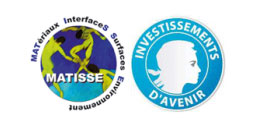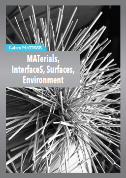NMR on soft matter - structure, dynamics and charges

Un séminaire du Pr. Ulrich Scheler du Leibniz-Institut für Polymerfoschung Dresden, Germany.
Date et lieu
- Jeudi 30 janvier 2020 à 11h
- Couloir 22 23, salle 317
Campus Pierre et marie Curie
Sorbonne Université
Présentation
NMR is ideally suited for the characterization of soft matter and disordered materials.Solid-state NMR provides insight into the structure of both a soft polymer and inorganic fillers [1]. In particular heteronuclear experiments shine light on the interfaces [2]. Relaxation NMR provides insight into molecular dynamics, if detected with a spectral dimension it permits correlating the dynamics with functional groups or structural elements [3, 4]. EPR of spinlabels covalently attached to polyelectrolytes in conjunction with linehspe analysis provides highly selective information on mobility [5]. Rheological NMR, which is NMR under the application of external shear for instance in a Searle or double cylinder cell allows studying the response of the local polymer dynamics to the shear. Measuring the spin-spin relaxation time under shear reveals some chain ordering for oligomers but a dominating effect of the loss of entanglements for polymers [6]. For silk fibroin the effect of shear on the aggregation has been shown [7].
The self-diffusion coefficient measured by pulsed-field gradient NMR gives a measure of the conformation of polymers in solution. Applying an electric field simultaneously moves charged species move and from the velocity the charge per molecules of complex is determined. This combination provides direct experimental measure of the condensation of counterions on polyelectrolytes or proteins and allows quantifying weak binding of small molecules or the formation of complexes [8]. Combining magnetic resonance imaging with pulsed-field gradient NMR allows the direct measurement of flow fields.
Références
- Vyalikh, A. ; Zesewitz, K. ; Scheler, U. Hydrogen bonds and local symmetry in the crystal structure of gibbsite Magnetic Resonance in Chemistry 48 (2010) 877-881
- Vyalikh, A. ; Simon, P. ; Rosseeva, E. ; Buder, J. ; Kniep, R. ; Scheler, U. Intergrowth and interfacial structure of biomimetic fluorapatite - gelatine nanocomposite : A solid-state NMR study Journal of Physical Chemistry / B 118 (2014) 724-730
- Vyalikh, A. ; Wang, De-Yi ; Wagenknecht, U. ; Heinrich, G. ; Scheler, U. Molecular dynamics in aluminum layered double hydroxides as studied by 1H T1p NMR measurements Chemical Physics Letters 509 (2011) 138-142
- Friess, K. ; Sagidullin, A ; Meier-Haack, J. ; Scheler, U. Polymer chain mobility in polyelectrolyte multilayers Polymer Science Series C 59 (2017) 108-111
- Lappan, U. ; Scheler, U. Polyanion substitution in polyelectrolyte complex dispersions studied by spin-label EPR spectroscopy Macromolecules 52 (2019) 7218-7223
- Wiesner, B. ; Kohn, B. ; Mende, M. ; Scheler, U. Polymer chain mobility under shear - a rheo-NMR investigation Polymers 10 (2018) ID1231
- Ohgo, K. ; Bagusat, F. ; Asakura, T. ; Scheler, U. Investigation of structural transition of regenerated silk fibroin aqueous solution by rheo-NMR spectroscopy Journal of the American Chemical Society 130 (2008) 4182-4186
- Böhme, U. ; Scheler, U. Counterion condensation and effective charge of poly(styrenesulfonate) Advances in Colloid and Interfaces Science 158 (2010) 63-67
Egalement dans la rubrique
MATISSE en chiffres
- 4 disciplines : Chimie, Physique, Sciences de la Terre, Patrimoine
- 400 permanents
Contact
Direction
Florence Babonneau
Administration
Communication
Emmanuel Sautjeau



